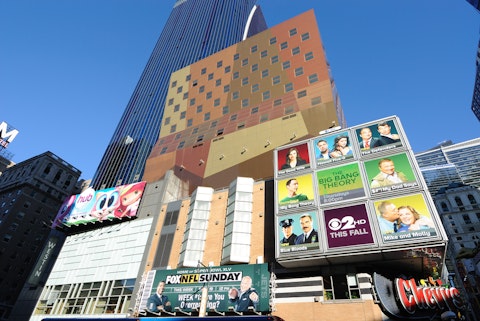In this article, we will look at the 10 Worst Advertising Stocks To Buy According to Short Sellers. Let’s look at where Haoxi Health Technology Ltd (HAO) stands against other worst advertising stocks.
Overview of the Global Advertising Sector
Advertising agencies have profited from per capita disposable income, increasing consumer spending, and corporate profit in the past few years. Although advertising expenditure fell after the outbreak of the COVID-19 pandemic, industry revenue in 2020 rose with companies demanding creative services for their pandemic-focused promotional campaigns. Corporate profit bounced back after 2020, allowing agencies to monetize the exponential release of pent-up demand as companies and businesses scrambled to target a specific customer base: one with increasing disposable income.
According to estimates from IBISWorld, industry-wide revenue in the advertising sector has been growing at a compound annual growth rate of 2.7% over the past five years. It is expected to reach $70.1 billion by 2024, increasing by 1.9%. Profit is also anticipated to grow by 6.6%. According to a report by Mordor Intelligence, the online advertising market is valued at $257.97 billion as of 2024. It is expected to increase to $431.76 billion by 2029, growing at a compound annual growth rate of 10.97% in the forecast period.
North America is the largest market in the sector and is also the fastest-growing in the world. The increasing use of digital devices and social media has caused an exponential boom in the online advertisement sector, becoming a critical component of marketing strategies for companies across the globe.
Spending in the Advertising Sector
Spending in the advertising industry, which determines the fate of publishers, is also determined by the state of the economy, consumer confidence, and advertisers’ outlook. Advertising giants have talked during earnings calls that while the advertising market is not at its best right now, it does appear to be recovering.
This recovery is taking place in areas such as food and technology, which joins strong performance in healthcare, pharmaceuticals, and beauty care. Companies that are active in programmatic advertising (data-driven user targeting through ads), have also seen programmatic revenues surge while broader advertising revenue decline.
US Elections and the Advertising Industry
US political campaigns take over the advertising landscape during an election season, setting the stage for a number of challenges for non-political advertisers. As such challenges only seem to grow with each election cycle, 2024 is no exception. Hotly contested Senate battles and a divisive Presidential race landscape are some of the factors driving unprecedented political ad spend. Estimates show that this year’s political ad spending is expected to stand between $10.2 billion and $12 billion. This translates to a 13%-30% increase from the 2019-2020 election cycle ad spend.
This creates a pressing need for advertising and marketing leaders from outside the political landscape to find creative ways to navigate the politics-saturated market and chalk out ways to make the most of their spending in a period of localized inventory scarcity and high demand. Advancements in generative AI are also likely to create a landscape of misinformation and disinformation, especially on social media. This brings an additional responsibility to advertisers to safeguard their brands and clients from the potential pitfalls of such AI-generated misinformation and harmful political content.
According to a report by Insider Intelligence, TV media is again expected to take the largest chunk of America’s political ad spending. It is anticipated to rise 7.9%, accounting for 71.9% of all spending. In addition, advertising costs on TV and other mediums are also expected to rise with the presidential campaign reaching its full swing. These trends will likely affect all kinds of advertisers, as TV, radio, and out-of-home advertising is anticipated to be rife with election advertising. This would make getting non-political messages across considerably harder, as there is expected to be considerable noise in the market between August and November.
Our Methodology
To list the 10 Worst Advertising Stocks to Buy According to Short Sellers, we used a Finviz screener to filter out stocks catering to the advertising industry. Next, we narrowed our list of stocks by selecting the ones having high short interest. Finally, the stocks were ranked in ascending order of their short interest. We also mentioned the hedge fund sentiment for each stock.
Why are we interested in the stocks that hedge funds pile into? The reason is simple: our research has shown that we can outperform the market by imitating the top stock picks of the best hedge funds. Our quarterly newsletter’s strategy selects 14 small-cap and large-cap stocks every quarter and has returned 275% since May 2014, beating its benchmark by 150 percentage points (see more details here).

Sean Pavone/Shutterstock.com
Haoxi Health Technology Ltd (NASDAQ:HAO)
Short Interest: 1.41%
Number of Hedge Fund Holders: 31
Haoxi Health Technology (NASDAQ:HAO) is an online marketing solutions company based in China. Its primary business is providing one-stop advertising marketing solutions through its media partners, such as online short video advertisements. Its specializations include the planning, production, placement, and optimization of online advertisements. The company’s cooperative media partners include authorized third-party agency media and media platforms such as TikTok and Toutiao. Essentially, the company provides its advertising services to customers and companies in the healthcare sector. However, it also conducts business with organizations and businesses in the domestic market.
Haoxi Health Technology (NASDAQ:HAO) holds considerable market experience in the online marketing industry, giving it a competitive advantage and establishing it for enhanced financial performance. It recently entered into a Framework Contract for Cooperation on Information Placement on Media Platforms with Wuhan Yiya Simei Dental Clinic Co., Ltd., a regional dentistry chain in China. This collaboration occurred through Haoxi Health Technology’s wholly owned subsidiary, Beijing Haoxi Digital Technology Co. Ltd. The partnership is furthering the company’s objective of delivering internet marketing solutions. As per the contract, Beijing Haoxi will provide elaborate advertising services to Yiya Dental through popular social media platforms such as Douyin, Toutiao, and Xigua Video. This includes various media forms, including text, images, short videos, flash, and even mobile app content.
In further efforts to expand its customer base and establish itself as a leader in the sector, the company entered a Bidding Data Promotion Rebate Agreement with Jinan Yanling Biotechnology Co., Ltd. and its subsidiaries and affiliated companies, which are collectively known as “Yanling.” This collaboration also took place through Haoxi Health Technology’s wholly-owned subsidiary, Beijing Haoxi Digital Technology Co. Ltd. As per the agreement, Beijing Haoxi will provide elaborate promotion and advertising services to Yanling through advertising platforms such as Douyin, Jinri Toutiao, and Xigua Video. 31 hedge funds hold stakes in the stock as of Q2 2024. It ranks tenth on our list of the 10 worst advertising stocks to buy, according to short sellers.
Overall, HAO ranks 10th among the worst advertising stocks to buy according to short sellers. While we acknowledge the potential of HAO as an investment, our conviction lies in the belief that AI stocks hold greater promise for delivering higher returns, and doing so within a shorter timeframe. If you are looking for an AI stock that is more promising than HAO but that trades at less than 5 times its earnings, check out our report about the cheapest AI stock.
READ NEXT: $30 Trillion Opportunity: 15 Best Humanoid Robot Stocks to Buy According to Morgan Stanley and Jim Cramer Says NVIDIA ‘Has Become A Wasteland’.
Disclosure: None. This article is originally published at Insider Monkey.





